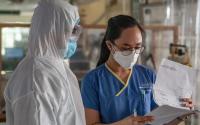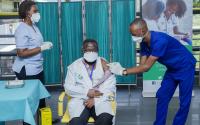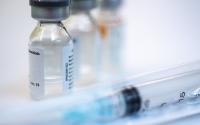[ad_1]
The greatest COVID-19 risk factors for healthcare personnel (HCP) aren’t patient contact or clinical duties but rather community exposure and prevalence, according to a JAMA Network Open study yesterday.
The study pulls together survey and serologic data from almost 25,000 US HCPs. It found that exposure to a positive community contact increased the likelihood of infection 3.5 times and high cumulative exposure increased the likelihood 1.8 times.
“The news is reassuring in that it shows the measures taken are working to prevent infections from spreading in healthcare facilities,” said study co-author Anthony Harris, MD, MPH, in a University of Maryland press release. “Vaccination for healthcare workers, however, should remain a priority because of continual exposures in the workplace.”
Table of Contents
Healthcare job, patient contact not significant factors
The researchers collected volunteer samples and survey data from 24,749 HCP across four large healthcare systems and three states (Georgia, Maryland, and northeast Illinois). Serologic tests looking for COVID-19 antibodies showed that, from Apr 19 to Aug 30, 2020, 4.4% of HCPs were positive, ranging from 3.1% (University of Maryland) to 5.7% (University of Emory).
Of the HCP, 69.6% were younger than 50, 78.2% were women, and 61.2% were White. About half (50.2%) of all participants had contact with COVID-19 patients in any way, and 35.9% worked in inpatient settings. The most common occupations were nurses (31.6%), nonclinical staff (21.4%), and physicians (18.2%); 9.7% worked in the emergency department.
Even though HCP were likely to have work-related contact with people infected by COVID-19, the adjusted odds ratio (aOR) did not show significantly increased risk (1.1; 95% confidence interval [CI], 0.9 to 1.3).
Working as a nurse also did not increase odds (aOR, 1.1; 95% CI, 0.9 to 1.3), nor did working in the emergency department (aOR, 1.0; 95% CI, 0.8 to 1.3). While environmental services such as physical, occupational, or speech therapy did show an increased likelihood of infection (aOR, 1.5; 95% CI, 0.8 to 3.1), the researchers say those data may be skewed because of the small sample size (122, 0.5%).
“Despite the close contact activity that HCP regularly participate in, such as obtaining medical histories, conducting physical examinations, and performing procedures—including aerosol-generating procedures with the highest risk of transmission—these activities occur within health care systems with infection prevention practices designed to protect individuals from communicable diseases,” write Shruti Gohil, MD, MPH, and Susan Huang, MD, MPH, in an invited commentary.
Community prevalence, exposure increase likelihood
Community factors, on the other hand, carried the highest risk of COVID-19 infection. Being in contact with someone from the community (eg, friend, housemate) increased likelihood by 3.5 (95% CI, 2.9 to 4.1).
Only 7.0% (1,730) of participants had a known COVID-19 exposure from the community, but of those, 12.6% had confirmed COVID-19 infection, compared with 3.5% of the 20,072 who said they didn’t have any COVID-19 community contacts.
Cumulative incidence in the community also affected infection likelihood, with an aOR of 1.8 (95% CI, 1.3 to 2.6). Data collected the week prior to participants’ COVID-19 tests showed that average prevalence was 72.4 infections per 10,000 people, but it could range anywhere from 8.2 to 275.6.
Additionally, age and race affected risk of infection. HCPs who were younger than 30 were more likely to be seropositive compared with those 60 and older (aOR, 1.3; 95% CI, 1.0 to 1.7), and as age increased, odds decreased. This could be because this age-group may convene more with friends, go out in the community more often, or have children who attend school or daycare, the researchers write.
Similar to other studies, the researchers also found that Black HCP, who made up 20.7% of the cohort, had double the odds of having COVID-19 antibodies than White HCP (aOR, 2.1; 95% CI, 1.8 to 2.4). The researchers point to existing disparities in the community as opposed to healthcare-related factors.
(Although the study did not find any significant associations between other races or ethnicities, the researchers note this could be due to low sample volume. Hispanics, for instance, made up only 4.5% of the study’s participants.)
Community control efforts needed
The study was not able to assess COVID-19 mitigations across the different sites, but the researchers say it nonetheless affirms that the control measures that healthcare systems use, such as disinfecting and personal protective equipment (PPE), are effective.
Furthermore, because of the focus on community-related risk, the commentary asks for continued investment in COVID-19 controls in healthcare providers’ communities. This should include partnerships between these large institutions and local organizations such as public health departments, community gathering centers such as schools, and non–hospital-based healthcare providers like nursing homes, Gohil and Huang write.
“The generalizability of the findings in the study by Jacobs et al may be limited to large health systems and particularly academic centers that have experience designing complex protocols to address patients with highly complex disease,” they add. “More data are needed on how to optimize HCP adherence to infection prevention protocols, including speaking up about symptoms and avoiding working while ill.”
[ad_2]
Source link












